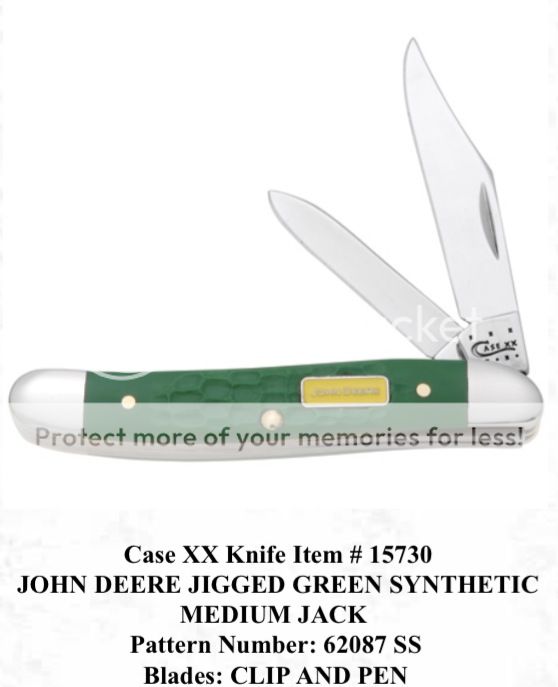FYI, this knife is bone, jigged, Rogers, or otherwise. If it was synthetic, it would have bben stamped 2207. If it was stag, it would have been stamped 5207.
That is not Delrin for the simple fact that it is a 6207. For it to have been Delrin/synthetic, it would have been designated a 2207.
I have a number of Case knives that start with the number 6 some are Jigged bone some are Jigged Delrin, it is a very common misconception that a 6 represents only bone, it can represent bone, but it represents all Jigged patterns
This is taken directly from Case's website
1 - Hardwood
This number is usually used for a hardwood, such as walnut. Walnut is a very durable and rugged hardwood used for working knives; such as, the 1199SH Pattern and the 12031 electrician's knife.
2 - Smooth Black Synthetic
Black poured plastic molded handles usually made from Delrin® or Thermoplastic Rubber.
3 - Yellow Synthetic
Smooth yellow poured plastic molded handles, called Delrin®.
4 - Smooth Synthetic
Poured plastic or Delrin® molded handles made in most any color except black and yellow.
5 - Stag
Naturally shed or dropped deer antlers are used for the Stag handles in Case knives. The most desirable Stag comes from the Sambar or Chital deer in India. Stag covers are burned lightly during the completion process.
5 - XX Prime Stag
Genuine India Stag with an extra rough texture - the best of the best.
M5 - Midnight Stag
Genuine Stag except it is treated with a black dye and the covers do not get burned during completion.
R5 - Red Stag
Genuine Stag except it is treated with a red dye and the covers do not get burned during completion.
V5 - Vintage Stag
Genuine Stag that is not dyed or burned during the manufacturing process, but is given extra buffing and hand finishing.
6 - Bone
Procured from Brazil, the shin bone of the Zebu cattle are the main source of bone suitable for Case bone handle materials.
Jigged Synthetic
Plastic molded covers with a jigged pattern.
Jigged Laminate
Laminated wood with a jigged pattern; such as used on the Folding Hunter.
V6 - Vintage Bone
Natural Bone with a special jigging pattern which has similar characteristic to stag.
6.5 - 6.5 BoneStag®
6.5 BoneStag®, a Case registered trademark, is bone handle which is jigged and treated with flame to achieve the look of stag antler material.
7 - Rosewood
A handle material that comes from a number of hardwood trees from rain forests. It has a rose colored effect and is becoming more rare. Case used this in many of their outdoor knives.
7 - Curly Maple
A knurly section of wood from a maple tree is used for handle material. The wood has a curled design, giving it a very distinct look.
7 - Curly Oak
A knurly section of wood from an oak tree is used for handle material. The wood has a curled design, giving it a very distinct look.
7 - Ebony
Comes from Africa. This black wood is also used in woodwind instruments.
7 - Desert Iron Wood
Comes from the deserts of SW America or Mexico, a heavy wood which is regarded as some of the most beautiful wood anywhere.
7 - Boi D'arc Wood
Comes from the Osage tree of Texas, this dense yellowish, orange wood is used frequently by Native Americans
7 - Zebra Wood
Comes from Africa, a hard, dense, beautiful wood, naturally striped like a Zebra.
7 - Tulip Wood
Comes from the Tulip trees, found in jungles and North America.
7 - Lace Wood
Comes from Burma Rain Forest and is a hardwood.
7 - Snake Wood
Comes from South America and is considered the heaviest wood on earth.
7 - Amboyna
Comes from SE Asia, only the burls from the Narra tree are used to give the numerous, beautiful swirls that comes out in the Amboyna handles.
8 - Mother-of-Pearl
Natural shells harvested by deep sea divers in various parts of the Pacific Ocean.
8 - Abalone/ Paua
Gathered in Mexico, Abalone shells are cut into thin "feathers", edges are glued in thin sheets with each sheet color matches and then laminated with a high pressure laminate into sheets for handle material. Paua is a similar shell found in New Zealand.
8 - Pink Mother-of-Pearl
Only pearl shells which are found in fresh water; no artifical color or enhancements added.
8 - Black Mother-of-Pearl
Rare shell harvested by deep sea divers in various parts of the Pacific Ocean; no artifical color or enhancements added.
9 - Corelon
A synthetic resin handle material developed in a wide variety of colors and patterns - similar to an imitation Mother-of-Pearl
9 - Imitation Mother of Pearl
Not currently used at Case, Imitation Pearl is a composite material that looks like mother of Pearl.
10 - Micarta
High pressure plastic laminate with either a paper or cotton cloth reinforcement substrate is used to make micarta. Micarta is a very durable handle material which is waterproof, impact resistant and polishes well. The lines and swirls that show in the finished knives are these layers of paper or cotton cloth.
10 - G-10
Using the same process as the Micarta, G-10, however, has a glass cloth reinforcement substrate for exceptional strength characteristics with a very high impact and tensile strength. The lines and swirls that show in the finished knives are these layers of glass cloth.
B - Celluloid
Waterfall is celluloid, cream in color with a ripple design resembling a waterfall.
RM - Celluloid
Christmas Tree is a very colorful celluloid with green, reds and some gold.
EX - Exotic
EX indicates that the handle material used is from a variety of the most unique and desirable materials available; such as, precious gemstones, giraffe and ostrich bones, etc.
GS - Celluloid
Goldstone is celluloid, colored with gold metal flakes.
I - Ivory
Since the last ice age, the Mammoth Ivory tusks have been locked in ice some 12,000 years. This is perhaps the most beautiful and exotic of all handle materials which Case uses.
I - Imitation Ivory
Not currently used at Case, Imitation Ivory is a composite material that looks like natural ivory.
P - Pakkawood
A laminated wood typically birch or maple, impregnated with clear resin and bonded together. Pakkawood has the natural beauty of finished wood and a high resistance to heat and moisture, especially developed for Case handles in 1948.
R - Celluloid
Candy Stripe is a celluloid material colored in a striped (vertical or horizontal) design.
Pete
Example Case 6201 10 dot
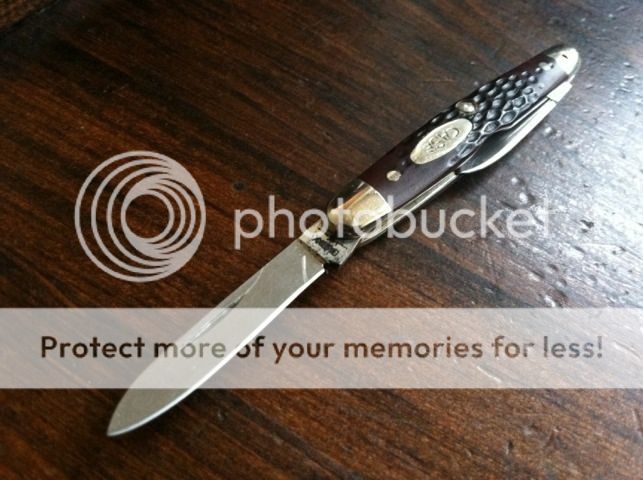
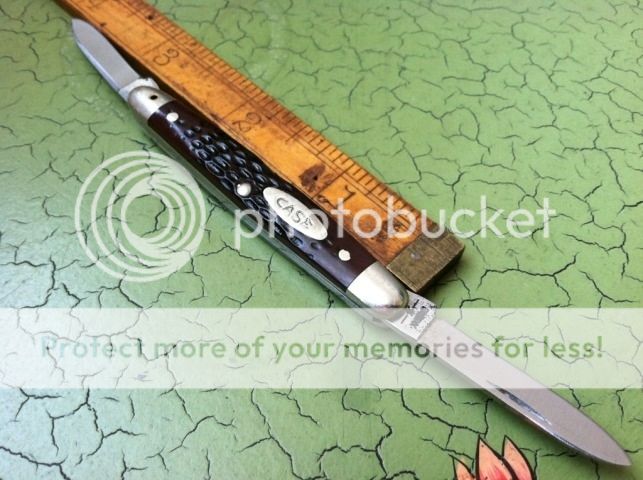
Case 6244 2 dot
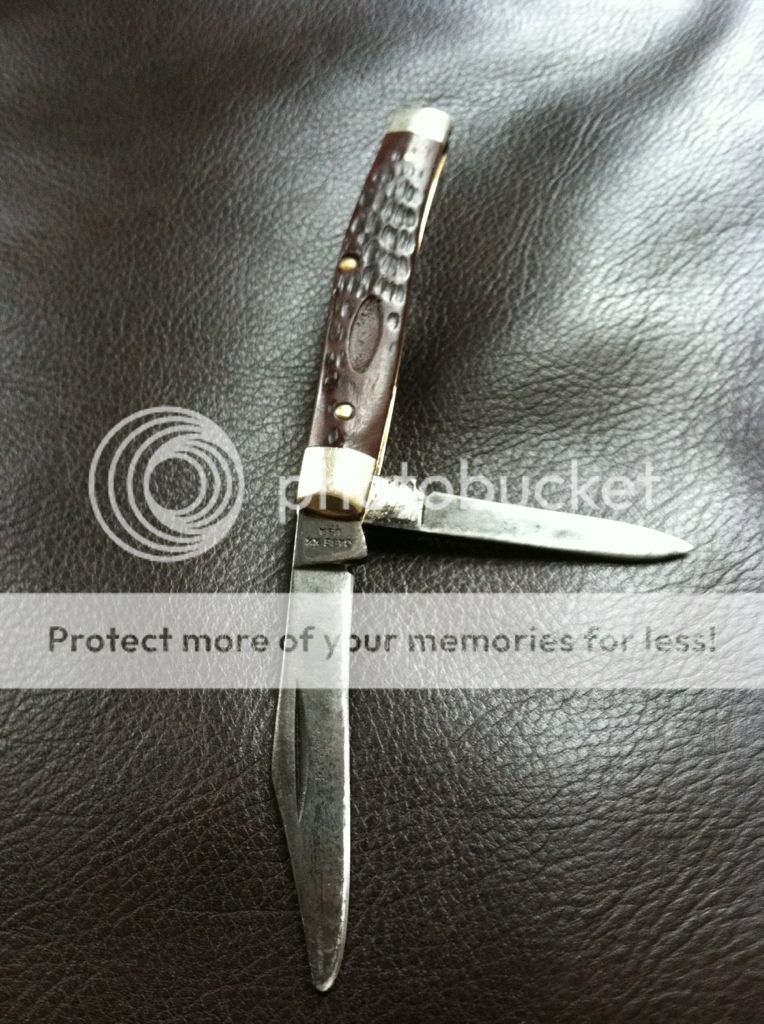
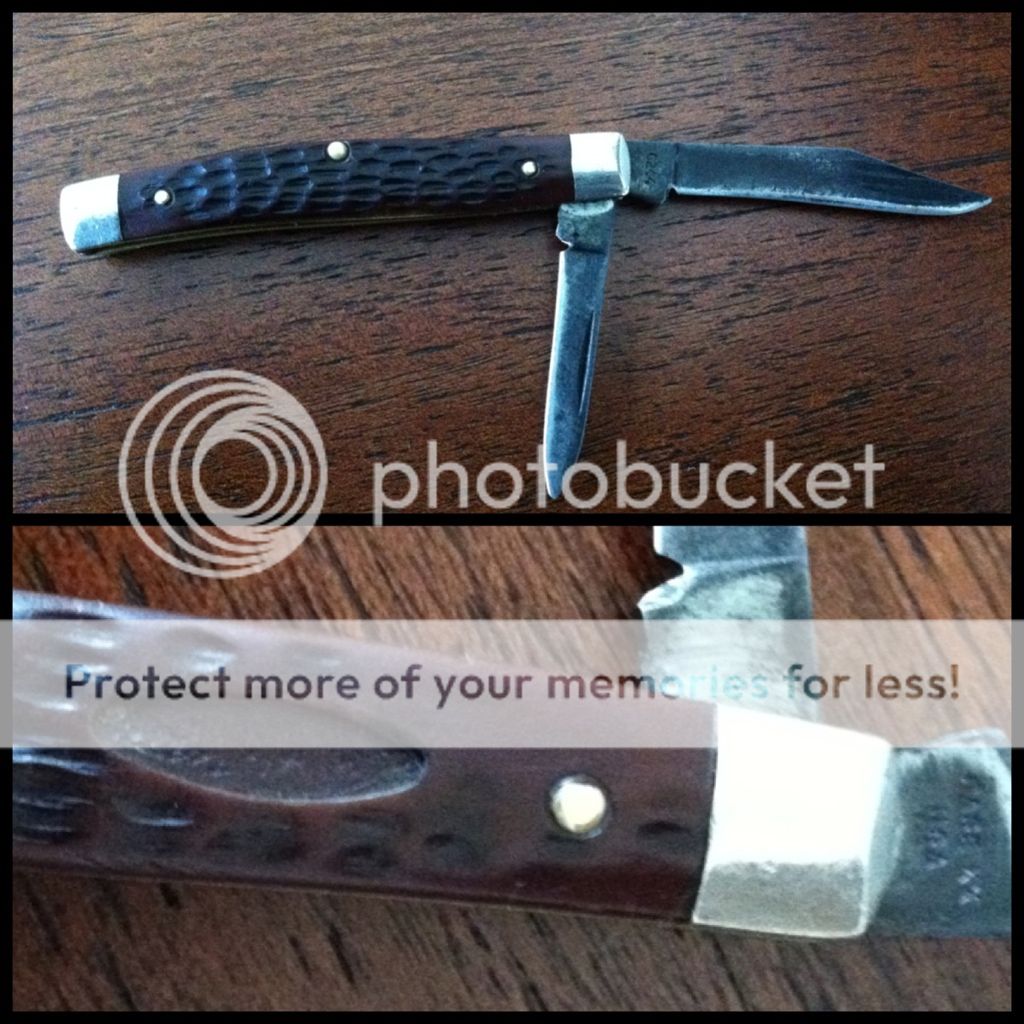
These knives are both jigged delrin and start with a #6
And from a currant website ad
